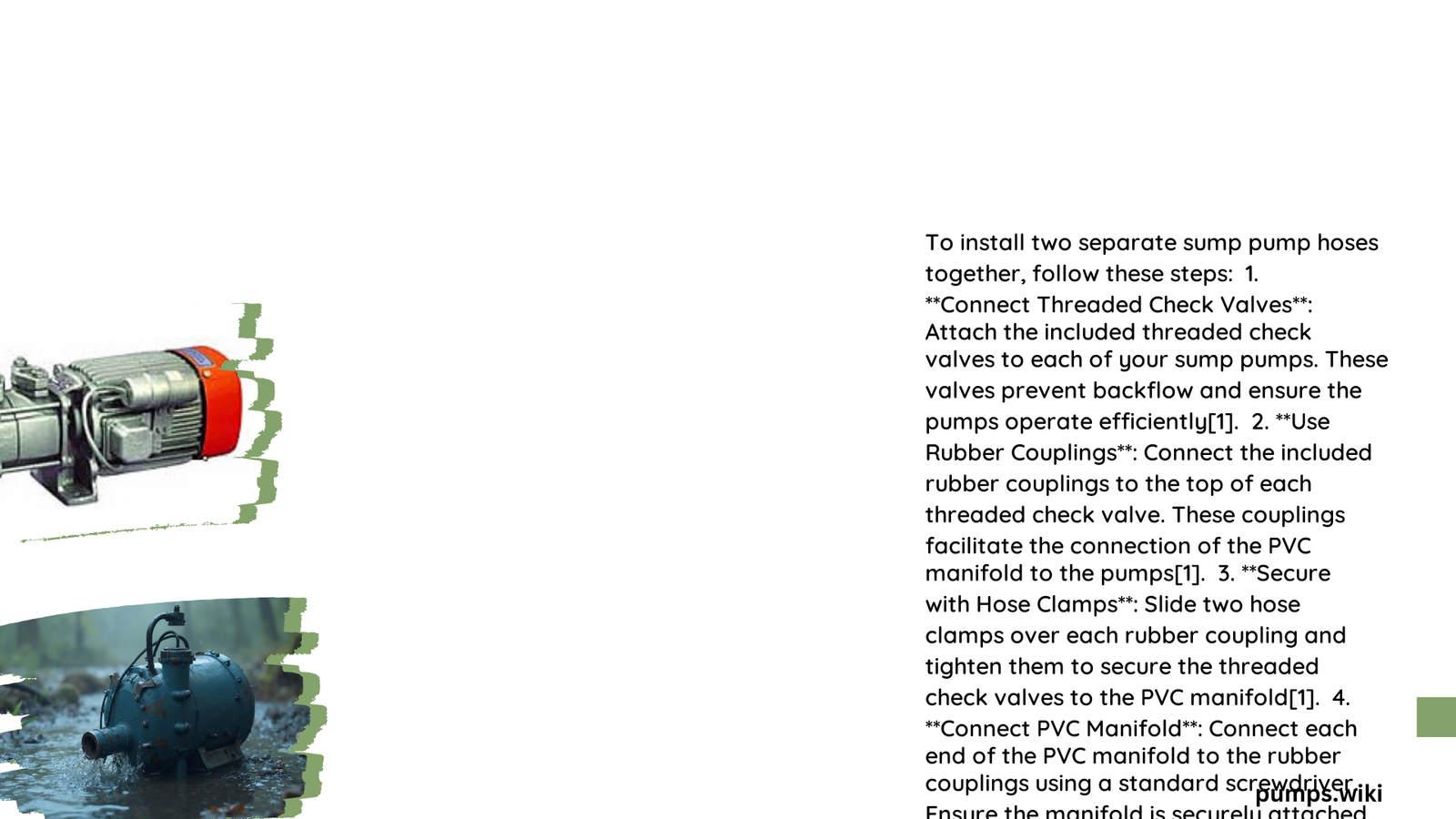Installing two separate sump pump hoses together is a crucial task for homeowners dealing with excess water in their basements. This process involves connecting multiple discharge pipes to ensure efficient water removal. Proper installation requires careful planning, the right materials, and attention to detail. This guide will walk you through the steps, considerations, and best practices for installing two separate sump pump hoses together.
What Tools and Materials Are Needed for Installing Two Separate Sump Pump Hoses?
Before beginning the installation process, gather the following tools and materials:
- PVC primer and cement
- PVC pipes (typically 1 1/4\” or 1 1/2\” diameter for residential use)
- Check valves
- Male-threaded adapters
- Rubber coupling boots
- Utility knife
- Hack saw
- Adjustable pipe wrench
- Screwdrivers
- Tape measure
- Safety glasses and gloves
Having these items on hand will ensure a smooth installation process and help you avoid unnecessary delays.
What Are the Different Hose Types and Connection Methods?

When installing two separate sump pump hoses together, you have several options for hose types and connection methods:
-
PVC Piping: This is the most common choice for sump pump discharge due to its durability and resistance to corrosion. PVC pipes are connected using PVC primer and cement for secure joints.
-
Rubber Coupling Boots: These are used to connect standard check valves to the discharge pipe. They provide a flexible, watertight seal and can be easily tightened with a screwdriver.
-
Barbed Fittings and Couplings: While not typically used for PVC piping, these can be employed for flexible discharge hoses. For PVC installations, threaded adapters and couplings are preferred.
How to Connect Two Separate Sump Pump Hoses?
Follow these steps to connect two separate sump pump hoses:
- Attach Check Valves:
- For glue-in check valves: Prime the inside of the fitting and the outer edge of the discharge piping, then apply PVC cement and attach the fitting.
-
For standard check valves: Use a rubber coupling boot to connect the valve to the discharge pipe.
-
Connect Adapters to PVC Pipes:
- Glue the male-threaded adapter to each PVC pipe using PVC primer and cement.
-
Thread the adapter-end of each PVC pipe onto its respective sump pump.
-
Cut and Clean Piping:
- Measure and cut the PVC pipes to the required length using a hack saw.
-
Deburr the cut edges with a utility knife to ensure smooth connections.
-
Join the Pipes:
- Use a Y-fitting or T-fitting to join the two separate discharge pipes into a single main discharge line.
- Apply PVC primer and cement to all connection points to ensure watertight seals.
What Is the Optimal Diameter and Length for Discharge Piping?
The optimal diameter and length of discharge piping are crucial for efficient water removal:
| Aspect | Recommendation |
|---|---|
| Diameter | 1 1/4\” or 1 1/2\” for residential use |
| Length | Measure from pump discharge to expulsion point |
- Diameter: Ensure it’s sufficient to handle the flow rate of both sump pumps without significant pressure drop.
- Length: Cut the PVC pipe a few inches longer than the measured length to allow for final adjustments.
How to Calculate Flow Rate and Consider Pressure?
When installing two separate sump pump hoses together, consider the following:
- Flow Rate: Choose a pipe diameter that can handle the combined gallons per hour (GPH) rating of both sump pumps.
- Pressure Considerations: Ensure the discharge pipe slopes away from the sump pit to prevent backflow. A slope of about 1/4 inch per foot is recommended.
What Are Potential Challenges and Their Solutions?
- Backflow Prevention:
-
Solution: Install a check valve on each discharge pipe to prevent water from flowing back into the sump pit.
-
Proper Slope for Drainage:
-
Solution: Ensure a slope of about 1/4 inch per foot away from the sump pit for smooth water flow.
-
Securing Connections to Prevent Leaks:
- Solution: Use PVC primer and cement for PVC connections. For rubber couplings, ensure they are tightly secured with clamps.
What Is the Cost Breakdown and Installation Timeframe?
Materials Cost:
- PVC Pipes: $10-$30 per 10-foot section
- Check Valves: $20-$50 each
- Male-Threaded Adapters: $5-$10 each
- Rubber Coupling Boots: $5-$10 each
- PVC Primer and Cement: $10-$20 per kit
- Tools: $20-$50 (if not already owned)
Estimated Total Cost: $150 to $400 for a basic setup with two sump pumps.
Installation Timeframe:
- DIY Installation: 4-8 hours
- Professional Installation: Typically one day
By following this guide, you can successfully install two separate sump pump hoses together, ensuring efficient water removal and protecting your basement from potential flooding.
References:
1. https://www.sumppumpsdirect.com/stories/80-How-To-Install-A-Primary-Sump-Pump.html
2. https://www.watersmartsystems.com/blog/2023/11/8/sump-pump-installation-guide
3. https://zoellerathome.com/2021/11/30/sump-pump-installation-guide/
